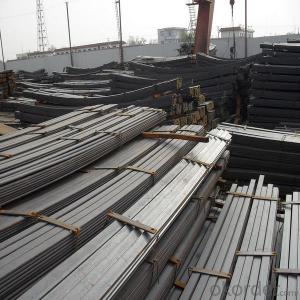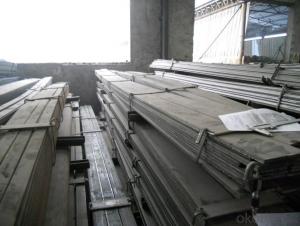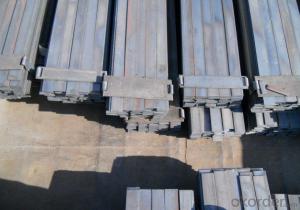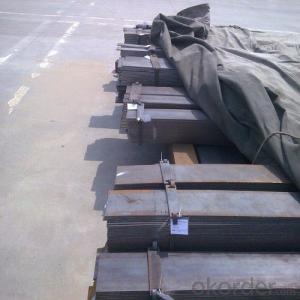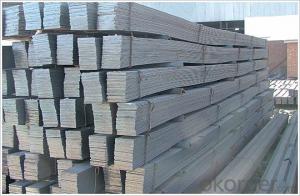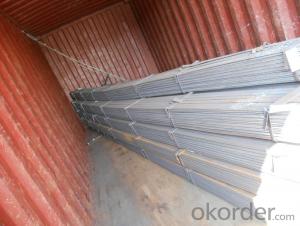Cold Rolled Drawn Slit Cutting Steel Flat Bar for Re-Selling
- Loading Port:
- China main port
- Payment Terms:
- TT or LC
- Min Order Qty:
- 25 m.t.
- Supply Capability:
- 10000 m.t./month
OKorder Service Pledge
OKorder Financial Service
You Might Also Like
1. Structure of Cold Rolled Drawn Slit Cutting Steel Flat Bar Description:
Cold rolled drawn slit cutting steel flat bar is a beam with an I-shaped cross-section. The horizontal elements of the "I" are known as flanges, while the vertical element is termed the "web". Cold rolled drawn slit cutting steel flat bar is usually made of structural steel and is used in construction and civil engineering. The cold rolled drawn slit cutting steel flat bar resists shear forces, while the flanges resist most of the bending moment experienced by the beam. Cold rolled drawn slit cutting steel flat bar theory shows that the I-shaped section is a very efficient form for carrying both bending and shears loads in the plane of the web.
2. Main Features of Steel Flat Bar Chinese Standard Slit and Cut Form:
• Grade: Q235
• Type: Mild carbon steel
• Deflection: The stiffness of the I-beam will be chosen to minimize deformation
• Vibration: The stiffness and mass are chosen to prevent unacceptable vibrations, particularly in settings sensitive to vibrations, such as offices and libraries.
• Local yield: Caused by concentrated loads, such as at the beam's point of support.
3. Steel Flat Bar Chinese Standard Slit and Cut Form Images:
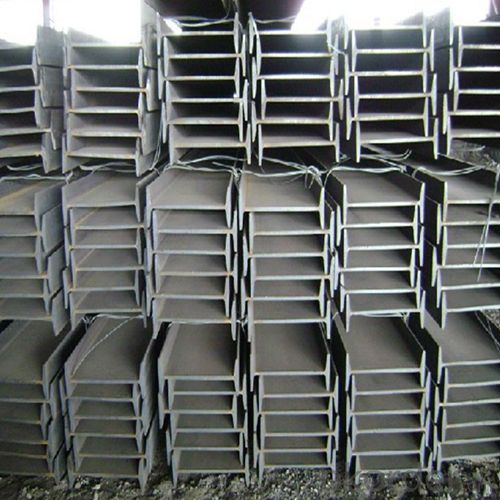
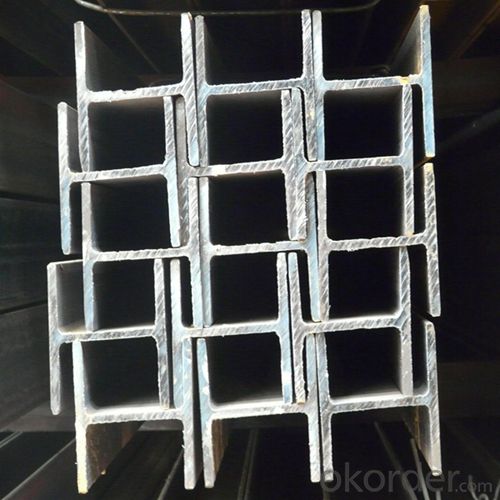
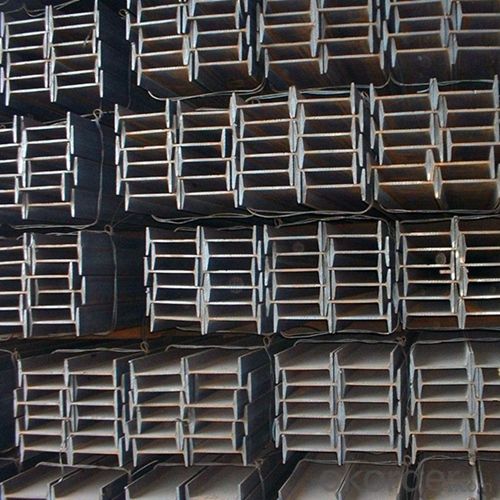
4. Steel Flat Bar Chinese Standard Slit and Cut Form Specification:
Alloy No | Grade | Element(%) | ||||
C
| Mn
| S
| P
| Si
| ||
Q235
|
B
|
0.12—0.20 |
0.3—0.7 |
≤0.045 |
≤0.045
|
≤0.3
|
Alloy No | Grade | Yielding strength point(Mpa) | Tensile strength (Mpa) | Elongation after fracture(%) | ||||||
Thickness (mm) | Thickness (mm) | |||||||||
≤16 | >16--40 | >40--60 | >60--100 | ≤16 | >16--40 | >40--60 | >60--100 | |||
≥ | ≥ | |||||||||
Q235 |
B |
235 |
225 |
215 |
205 |
375--500 |
26 |
25 |
24 |
23 |
5. FAQ
We have organized several common questions for our clients,may help you sincerely:
①Is this product same as W beam?
In the United States, the most commonly mentioned I-beam is the wide-flange (W) shape. These beams have flanges in which the planes are nearly parallel. Other I-beams include American Standard (designated S) shapes, in which flange surfaces are not parallel, and H-piles (designated HP), which are typically used as pile foundations. Wide-flange shapes are available in grade ASTM A992,[4] which has generally replaced the older ASTM grades A572 and A36.
②How to inspect the quality?
We have a professional inspection group which belongs to our company. We resolutely put an end to unqualified products flowing into the market. At the same time, we will provide necessary follow-up service assurance.
③Is there any advantage about this kind of product?
Steel I beam bar IPE has a reduced capacity in the transverse direction, and is also inefficient in carrying torsion, for which hollow structural sections are often preferred.
- Q:Can steel flat bars be used for making stair treads or steps?
- Stair treads or steps can indeed be made using steel flat bars. The robustness and durability of steel make it an excellent choice for providing stability and support to staircases. By conveniently fabricating and molding flat bars, one can effortlessly fashion treads or steps that are not only functional but also visually appealing. Moreover, steel's ability to resist corrosion renders it suitable for outdoor or heavily frequented locations where stairs are typically found. Nevertheless, it is crucial to carefully deliberate on the thickness and dimensions of the steel flat bars to guarantee their ability to endure the anticipated weight and fulfill the essential safety requirements.
- Q:What are the different types of steel alloys used for flat bars?
- A variety of steel alloys are commonly utilized for flat bars, each possessing its own unique properties and advantages. Some prominent examples include: 1. Carbon Steel: The fundamental and extensively employed steel alloy for flat bars, consisting predominantly of iron and carbon, with minor amounts of other elements. Carbon steel is renowned for its strength and durability, rendering it suitable for diverse applications. 2. Stainless Steel: This steel alloy contains a significant proportion of chromium, providing exceptional resistance to corrosion. Stainless steel flat bars are frequently employed in environments exposed to moisture or harsh chemicals. 3. Alloy Steel: This classification encompasses a broad range of steel alloys specifically formulated to enhance particular properties. For instance, certain alloy steels exhibit heightened strength, while others possess improved heat or wear resistance. Alloy steel flat bars find common usage in industries such as construction, automotive, and manufacturing. 4. Tool Steel: This particular steel alloy is specifically engineered to possess elevated hardness, wear resistance, and toughness. Tool steel flat bars are commonly employed in the production of tools, dies, and molds. 5. Spring Steel: As the name suggests, this steel alloy is renowned for its ability to retain shape and strength even when subjected to repeated bending or twisting. Spring steel flat bars are extensively utilized in the manufacturing of springs, clips, and other components requiring elasticity. These examples illustrate merely a fraction of the diverse steel alloys employed for flat bars. The choice of alloy depends on the specific application and desired properties, such as strength, corrosion resistance, or wear resistance.
- Q:Cold rolled flat steel standard. What is cold rolled flat steel?
- Section steel is one of the four major steel products (plate, tube, mould, wire). According to the section shape, the section steel is divided into simple section steel and complex section steel (deformed steel). The former refers to the steel, round steel, flat steel, angle steel, six angle steel; the latter refers to the I-beam, channel steel, steel, steel, steel frame bending etc..
- Q:What are the common surface treatments for steel flat bars?
- There are several common surface treatments for steel flat bars that are used to enhance their appearance, durability, and resistance to corrosion. These treatments include: 1. Hot-dip galvanizing: This process involves immersing the steel flat bars in a bath of molten zinc, which creates a protective zinc coating on the surface. Galvanizing provides excellent corrosion resistance and can extend the lifespan of the steel flat bars. 2. Powder coating: Powder coating involves applying a dry powder to the surface of the steel flat bars and then heating it to create a durable, protective finish. This treatment offers a wide range of colors and provides excellent resistance to scratching, chipping, and fading. 3. Electroplating: Electroplating is a process in which a thin layer of metal, such as zinc, nickel, or chrome, is deposited onto the surface of the steel flat bars using an electric current. This treatment improves the appearance of the bars, enhances their corrosion resistance, and can provide a decorative finish. 4. Painting: Painting is a common surface treatment for steel flat bars, where a layer of paint is applied to the surface to provide both aesthetic appeal and protection against corrosion. Various types of paints, including epoxy, polyurethane, and enamel, can be used depending on the specific application requirements. 5. Anodizing: Anodizing is mainly used for aluminum, but it can also be applied to steel flat bars. This process involves creating an oxide layer on the surface of the metal through electrolysis, which enhances corrosion resistance and provides a decorative finish. These surface treatments for steel flat bars are widely used in various industries, including construction, automotive, manufacturing, and infrastructure projects. The choice of treatment depends on the specific requirements of the application, such as desired aesthetics, durability, and corrosion resistance.
- Q:Can steel flat bars be used in electrical or electronic equipment?
- Indeed, electrical or electronic equipment can utilize steel flat bars effectively. These bars are frequently employed as mounting or support components in such equipment owing to their exceptional strength and resilience. They offer stability and structural integrity to the equipment, especially in scenarios where weight or load-bearing capability holds significance. Moreover, steel flat bars can serve as conductive elements in specific electrical or electronic systems, given their commendable electrical conductivity properties. Nevertheless, it is crucial to acknowledge that steel is an electricity conductor, necessitating adherence to appropriate insulation and grounding techniques to avert any electrical hazards.
- Q:Are steel flat bars suitable for making furniture or fixtures?
- Yes, steel flat bars are suitable for making furniture or fixtures. They are strong, durable, and provide a modern and industrial aesthetic. They can be easily manipulated and welded to create various shapes and designs for furniture or fixtures.
- Q:Galvanized flat steel how much is one meter?
- Formula of flat steel: width * thickness * 0.00785 (kg/m), zinc coating weight: 1.06Galvanized pipe formula: (outer diameter wall thickness) * wall thickness * 0.02466 * 1.06, DN25 galvanized pipe outer diameter 33.5, GB thickness 3.25, weight: 2.57kg/m, DN32, outer diameter 42.3, wall thickness 3.25, weight: 3.32kg/m. DN stands for nominal caliber.Angle formula (approximate): edge width * thickness * 0.015, 4# angle iron weight 2.422kg/m
- Q:How do you store steel flat bars to prevent damage?
- To ensure the steel flat bars are stored properly and protected from damage, there are several important steps to consider: 1. Select a suitable storage area: It is crucial to choose a clean, dry, and well-ventilated space for storage. Avoid areas with high moisture levels or extreme temperature changes. If possible, designate a specific area exclusively for storing steel flat bars to minimize the chances of damage. 2. Use proper stacking methods: When stacking multiple steel flat bars, place them horizontally on a flat surface. Make sure they are aligned properly and parallel to each other. Avoid stacking them too high to prevent excessive weight that could cause bending or warping. 3. Employ suitable supports: Insert timber or rubber supports between each layer of stacked flat bars. These supports will prevent direct contact between the bars, reducing the risk of scratches or surface damage. They also help distribute weight evenly and maintain the flatness of the bars. 4. Protect against moisture: Moisture can lead to rust or corrosion on steel flat bars. To prevent this, consider using moisture-absorbing materials like silica gel packets or desiccants in the storage area. Additionally, cover the stacked bars with a plastic sheet or tarp to shield them from moisture and humidity. 5. Maintain an organized inventory: Keep a thorough record of the stored steel flat bars, including their dimensions, grades, and quantities. Regularly inspect the inventory to identify any signs of damage, rust, or deformation. This will allow you to address any issues promptly and prevent further damage. 6. Take precautions during handling and transportation: When moving or transporting steel flat bars, use appropriate lifting equipment such as forklifts or cranes to avoid putting excessive stress on the bars. Always handle them with care and avoid dropping or dragging them, as these actions can result in dents, scratches, or deformation. By following these guidelines, you can ensure the proper storage of steel flat bars and minimize the risk of damage, thus preserving their quality and integrity.
- Q:What are the common industries that use steel flat bars?
- Steel flat bars are commonly used in various industries due to their versatility and strength. Some of the common industries that utilize steel flat bars include construction, manufacturing, transportation, and machinery. In the construction industry, steel flat bars are widely used for structural frameworks, support beams, and reinforcement in buildings, bridges, and other infrastructure projects. They provide stability, durability, and resistance to heavy loads, making them essential components in construction applications. Manufacturing industries also heavily rely on steel flat bars for a wide range of purposes. They are used in the production of machinery, equipment, and tools due to their excellent mechanical properties. Steel flat bars are often utilized in manufacturing processes such as welding, fabrication, and machining, where they can be easily shaped, cut, and manipulated. The transportation sector extensively uses steel flat bars in the construction of vehicles such as cars, trucks, buses, and trains. These bars can be found in the chassis, frames, and support structures of vehicles, ensuring their strength, stability, and safety. Moreover, steel flat bars are commonly employed in the machinery industry. They are utilized in the fabrication of machine components, such as brackets, supports, and frames, due to their high tensile strength and resistance to deformation. Steel flat bars also find application in agricultural equipment, mining machinery, and industrial machinery. In summary, the common industries that use steel flat bars include construction, manufacturing, transportation, and machinery. These industries rely on steel flat bars for their durability, strength, and versatility, making them essential components in various applications.
- Q:Are steel flat bars susceptible to rusting?
- Yes, steel flat bars are susceptible to rusting because they are made primarily of iron, which is prone to oxidation when exposed to moisture and oxygen in the environment.
1. Manufacturer Overview |
|
|---|---|
| Location | |
| Year Established | |
| Annual Output Value | |
| Main Markets | |
| Company Certifications | |
2. Manufacturer Certificates |
|
|---|---|
| a) Certification Name | |
| Range | |
| Reference | |
| Validity Period | |
3. Manufacturer Capability |
|
|---|---|
| a)Trade Capacity | |
| Nearest Port | |
| Export Percentage | |
| No.of Employees in Trade Department | |
| Language Spoken: | |
| b)Factory Information | |
| Factory Size: | |
| No. of Production Lines | |
| Contract Manufacturing | |
| Product Price Range | |
Send your message to us
Cold Rolled Drawn Slit Cutting Steel Flat Bar for Re-Selling
- Loading Port:
- China main port
- Payment Terms:
- TT or LC
- Min Order Qty:
- 25 m.t.
- Supply Capability:
- 10000 m.t./month
OKorder Service Pledge
OKorder Financial Service
Similar products
New products
Hot products
Hot Searches
Related keywords
